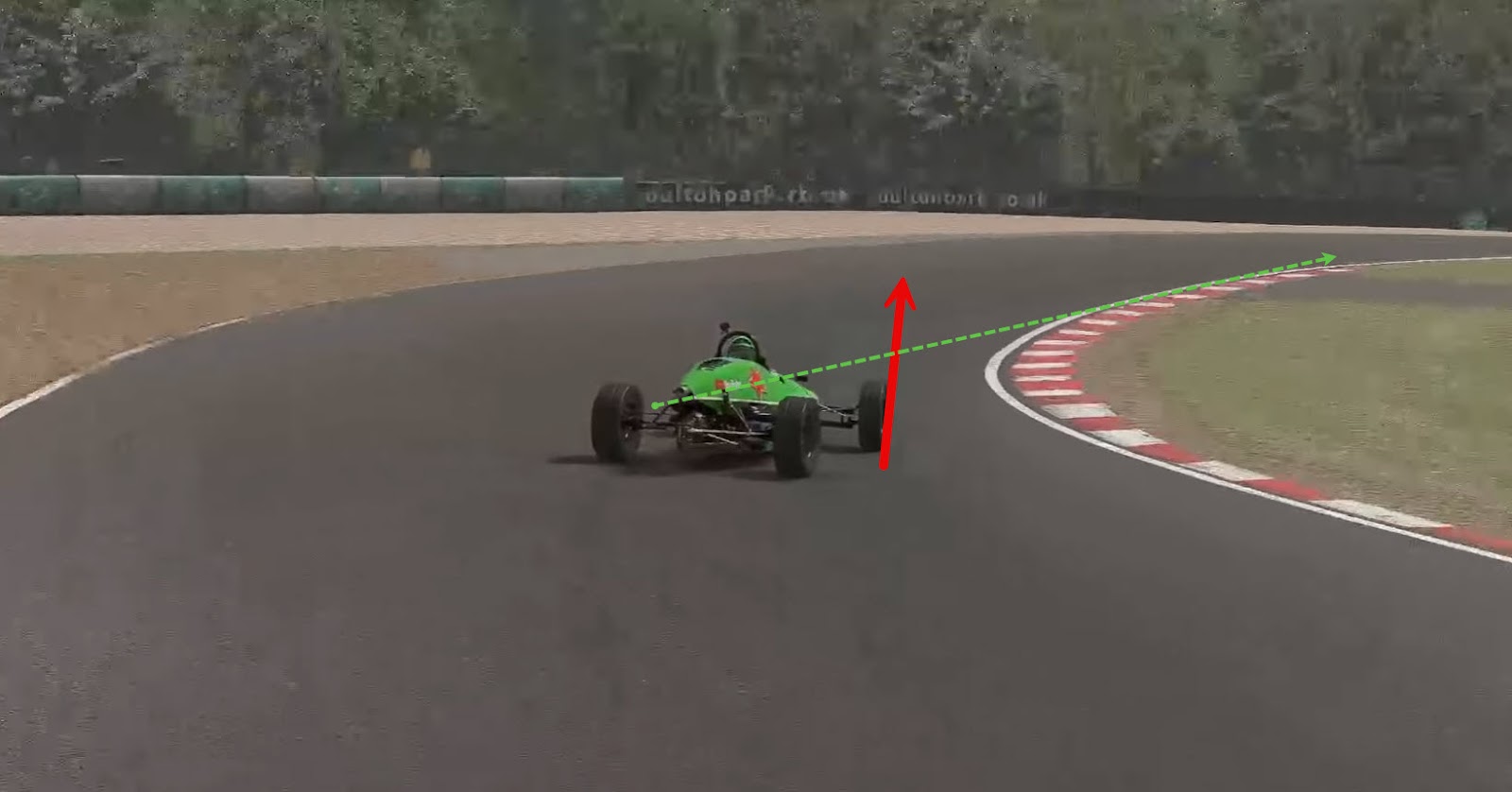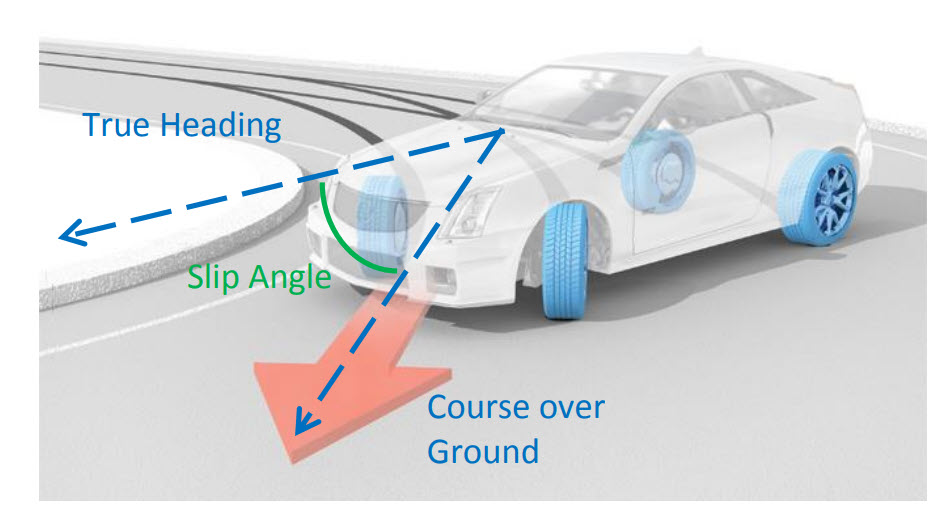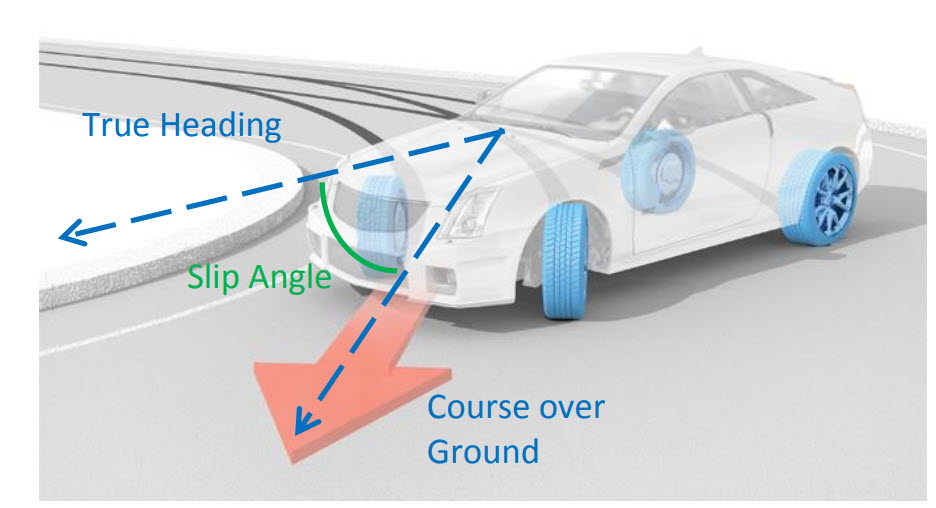Sim Racing
Why Your Car Won't Turn (Or Turns Too Much): Understanding Oversteer, Understeer and Slip Angle
You're approaching a corner flat out. The car feels planted through the initial left, but as you transition right, the rear suddenly steps out. Your hands flick the opposite lock instinctively, but it's too late. You're spinning across the track, watching helplessly as other drivers sail past. Sound familiar?
November 6, 2025
Here's the thing: most sim racers treat oversteer and understeer as problems to fix rather than physics to understand. They'll spend hours tweaking setup values without grasping why their car behaves the way it does.
Today, we're going to change that by exploring the fundamental physics that governs every corner you'll ever take - slip angle.

Huge amount of entry oversteer: front wheels correcting the oversteer (direction - red)
The Fundamentals Explained
Let's start with a truth that might surprise you: your tyres are always slipping. Even when the car feels completely stable, there's a difference between where your wheels are pointing and the direction your car is going. This difference is called slip angle, and it's the foundation of all car control.
Think of pushing a shopping trolley sideways across a car park. The wheels point one way, but the trolley moves at an angle. That's essentially what your racing tyres do, except they're designed to generate grip while doing it. Racing tyres produce their maximum grip at around 6-10 degrees of slip angle - they need to slide slightly to work properly.
This is where oversteer and understeer come in. They're not mysterious forces acting on your car; they're simply descriptions of which end of the car has exceeded its optimal slip angle first.
Understeer happens when your front tyres exceed their optimal slip angle before the rears. The front wheels are sliding more than ideal, reducing their ability to change the car's direction. You turn the wheel, but the car pushes wide.

A diagram explaining Understeer
Oversteer occurs when your rear tyres exceed their optimal slip angle first. The back end slides more than the front, causing the car to rotate more than you intended. The car turns too much, potentially leading to a spin.

A diagram explaining Oversteer
How to Recognise These Conditions
In real racing, drivers feel slip angle through their entire body - the g-forces, the seat pressure, the subtle movements of the car. In sim racing, we rely primarily on force feedback (FFB) and visual cues.
Here's what to watch for:
Recognising Understeer
Through FFB:
- The wheel becomes lighter as front tyres exceed optimal slip
- You feel less detail and texture through the wheel
- The self-centring force diminishes
Visual Indicators:
- The car's trajectory drifts wider than your intended line
- You feel need to increase steering input to maintain the corner
- The apex seems to move further away as you approach it
Telemetry Signatures:
- Front tyre temperatures spike (especially outer edges)
- Steering angle increases without proportional direction change
- Speed scrub without corresponding rotation
Recognising Oversteer
Through FFB:
- Sudden lightness followed by rapid loading
- The wheel wants to self-centre or counter-steer
- Quick oscillations as the rear breaks away
Visual Indicators:
- The car rotates more than your steering input suggests
- Track edges appear in your peripheral vision unexpectedly
- The rear of the car feels like it's "coming around"
Telemetry Signatures:
- Rear tyre temperatures spike
- Yaw rate exceeds steering input
- Rear wheel speed differential (outside wheel spinning faster)
Practical Technique: Managing Slip Angle
Understanding slip angle transforms how you approach car control. Instead of fighting against physics, you're working with them. Here's how to apply this knowledge:
The Weight Transfer Method
Your primary tool for managing slip angle is weight transfer. By shifting the car's weight, you change how much load (and therefore grip) each tyre has available.
Step 1: Anticipate the Balance Before entering any corner, visualise where the car's weight will be:
- Heavy braking = weight forward = more front grip, less rear
- Acceleration = weight rearward = more rear grip, less front
- Steady state = weight balanced = even grip distribution
Step 2: Use Throttle and Brake as Balance Controls. Think of your pedals as grip adjusters:
- Experiencing understeer? Lift slightly to transfer weight forward
- Fighting oversteer? Get gently back on throttle to stabilise the rear
- Need quick rotation? A brake tap shifts weight forward instantly
Step 3: Progressive Inputs Sudden inputs cause rapid weight transfer, easily exceeding optimal slip angles. Instead:
- Roll onto the brakes smoothly
- Squeeze the throttle progressively
- Turn the wheel in one fluid motion
Advanced Technique: Playing with Slip Angle
Once you understand weight transfer, you can deliberately induce specific slip angles:
Inducing Helpful Oversteer (Rotation):
- Approach corner with slightly less brake pressure
- Turn in while trailing off the brakes
- As weight transfers forward, the rear becomes light
- Use this moment to rotate the car toward the apex
- Apply throttle to stabilise or use a harsher throttle input to induce oversteer
Managing Understeer Mid-Corner:
- Recognise the push (car running wide)
- Lift off the throttle to move more weight transfer to the front giving you more front grip
- Reduce steering angle momentarily
- Reapply throttle smoothly as front grip returns

A basic slip angle diagram
Practice Drill: The Slip Angle Awareness Exercise
Here's a specific drill to develop your feel for slip angles:
Track: Tsukuba Circuit (or any track with a variety of corner speeds)
Car: Mazda MX-5 (or similar low-power, rear-drive car)
Setup: Slightly reduce rear tyre pressure (2-3 PSI) to make oversteer more progressive (depending on the game) in iRacing, you always drive at the lowest possible pressure.
The Exercise:
- Turn 1 (Hairpin): Practice inducing slight oversteer on entry using lift-off. Feel how the car rotates, then stabilise with throttle.
- Turns 3-4 (S-curves): Focus on weight transfer between left and right. Notice how the car wants to oversteer as you transition.
- Turn 5 (Long right): Hold a steady throttle and feel the understeer build. Practice breathing off throttle to adjust your line.
- Final Corner: Use trail braking to find the exact point where the front tyres reach optimal slip angle.


